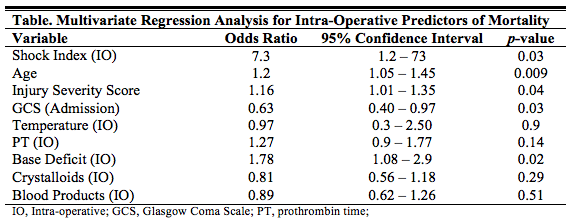B. Zangbar1, B. Joseph1, K. Ibraheem1, N. Kulvatunyou1, A. Tang1, T. O’Keeffe1, L. Gries1, R. Latifi1, R. S. Friese1, P. Rhee1 1University Of Arizona,Trauma Surgery,Tucson, AZ, USA
Introduction: Shock index (SI=Heart rate/Systolic Blood Pressure) is a well-established measure for predicting adverse outcomes in trauma patients. Intra-operative vital signs and lab data is likely to affect the surgeons decision during the operation. However the impact of intra-operative shock index (IOSI) on trauma patient outcomes has not been assessed. The aim of this study was to assess the impact of shock index on mortality in patients undergoing damage control laparotomy.
Methods: We performed an 8-year (2006 – 2013) retrospective analysis of all trauma patients undergoing an exploratory laparotomy. Patients ≥ 18 y/o who underwent a damage control laparotomy were included. Intra-operative vital signs, blood gas, coagulation profile, and volume of blood products and crystalloids used during the operation were collected by chart review. Patients were divided into two groups of IOSI ≥ 1, and IOSI < 1 and the outcomes were compared in two groups. Our outcome measure was in-hospital mortality. Regression analysis was performed.
Results:A total of 150 patients were included in our analysis. Mean age was 38 18, 70% were male, median ISS was 29 [17 – 41], and overall mortality rate was 47%. 35% of the patients had a shock index ≥ 1. Patients with an IOSI ≥ 1 had a higher mortality rate (57% vs. 15%, p < 0.001).
Conclusion:Shock continues to be a major cause of mortality and it is often reversible. Intraoperative shock index is a strong predictor of mortality in patients undergoing DCL. Optimization of resuscitation in the identified patients may help improve the outcomes.
